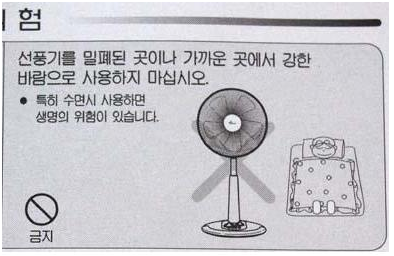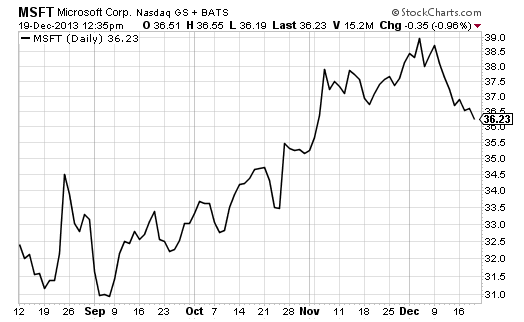 I’m not making this up.
I’m not making this up.
In South Korea, there’s a widespread belief that you can die if you sleep in a closed room with an electric fan that’s turned on.
Again – I’m not making this up. How could I?
Depending on who you ask, the belief is that you’ll die from hypothermia, suffocation or carbon dioxide poisoning.
One of Korea’s largest fan manufacturers puts a warning on their fans telling people that their product could cause suffocation or hypothermia.
 Of course, electric fans aren’t really deadly. And there’s slim evidence of even a single death being attributed to an electric fan.
Of course, electric fans aren’t really deadly. And there’s slim evidence of even a single death being attributed to an electric fan.
[ad#Google Adsense 336×280-IA]But that doesn’t stop the entire country of South Korea from believing it.
From their perspective, electric fans can kill you dead – so they wouldn’t stand to gain much by doubting this belief.
Laugh if you must – but there’s a similar irrational fear that you probably hold near and dear as an American investor.
In short, Americans seem to have an extreme aversion to selling puts.
Why?
Like our Korean friends who fear electric fans, American investors have “heard of” stories of people losing everything after selling puts. Or maybe, they just believe it’s inherently risky.
And this belief has certainly been reinforced by the mainstream financial media.
Simply put: most “experts” in the financial media portray this kind of strategy as too complicated for the average investor. Again, they want you to buy the next hot stock.
For whatever reason, there’s no doubting it – this fear of selling puts exists. The fear is real. But the evidence for this fear is scant.
On one hand, electric fans can kill you – if you drop them in with you while you’re taking a bath. But only under those particular circumstances are they even remotely dangerous.
And yes, selling puts can be dangerous – but only if you use them in incredibly stupid ways – the equivalent of dropping an electric fan into the bath.
But I can guarantee that once you learn how to use this type of investment, you will immediately begin to see the whole world of finance in a different light. Instead of “paying” people to invest your hard-earned money, you learn to get paid to invest. I know it sounds like a strange concept, but hear me out because it’s a strategy professionals have used successfully for years.
The first key to selling puts safely and profitably is knowing the real risks in owning a company’s shares. We need to assure ourselves the companies we sell puts on are fundamentally sound.
For instance, take Microsoft (MSFT).
It’s a company that we feel comfortable owning for the long haul mostly due to its unwavering quest to please shareholders. The company continually buys back stock and pays a healthy dividend of 3.1%.
The stock is currently trading for $36.23.
 In my opinion, the price is a little inflated. So I prefer to pay $33.
In my opinion, the price is a little inflated. So I prefer to pay $33.
Remember when I said we want to get paid to be investors? Well, given our desire to own Microsoft at $33 – we can get paid. Think about that: we can get PAID to agree to buy a stock at a lower price that we prefer.
I don’t want to get into the details in this short column, but we can sell one put contract that gives us the ability to buy 100 shares of Microsoft at $33 a share – and collect an immediate $60.
And no matter what happens, we get to keep that $60. If Microsoft stays above $33 – the $60 we collected is ours.
But for the sake of understanding, we should examine the alternative – Microsoft closing below $33 by option expiration.
In that case, we’d keep the $60 and be forced to buy Microsoft stock at $33 per share.
In this case, we’d actually own the stock for $32.40 per share – that’s the $33 strike price minus the $0.60 premium. That 10.6% less than Microsoft’s current market price.
Here’s that math:
Initial income from sold put premium – $60.
Purchase 100 shares of Microsoft at $33 – $3,300
Initial outlay: $3,240
The important thing to remember is that if the stock trades below $33 by option expiration, you become a shareholder just like everyone else … but at a discount.
Plus you’d get the dividend going forward of at least $92 per 100 shares, as each share pays a 92-cent annual dividend.
One way to think about it is that you’d receive $152 on a $3,240 investment. This works out to 4.7% on your money.
To me, this safe 4.7% return is superb given the current yields on bonds and other safe investments . . . and the likelihood of Microsoft raising dividends going forward.
Simply, selling puts is not inherently dangerous. If used correctly, it’s no more dangerous than any other type of investment.
And if you’re interested in income, it’s something you owe to yourself to look into.
— Andy Crowder
[ad#wyatt-income]
Source: Wyatt Investment Research


